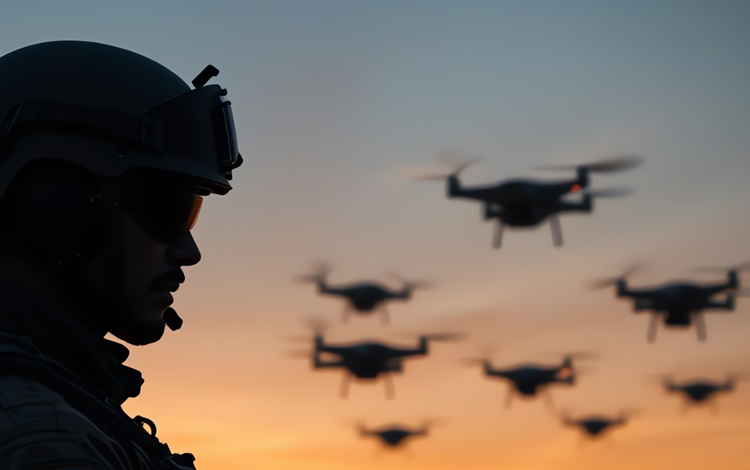Cooperative Autonomous Sensing Platform for Enhanced Reconnaissance
The term “swarm” is borrowed from biology, and it describes a real phenomenon we observe daily: a colony of ants, a school of fish, a flock of birds, or a hive of bees. Each of these examples showcases breathtaking self-organization, where individuals with limited sensing, communication, and intelligence come together to create a collective capable of achieving remarkable feats, such as finding food, building shelters, and surviving.
The secret to this behavior is not centralized command and control. For instance, bees don’t wait for detailed orders to collect food. Instead, they communicate simple information that other bees can interpret on the fly, allowing them to adapt and continually gather resources. There is no central brain consuming energy to instruct each member on what to do. Instead, intelligence emerges from the collective itself. This decentralization—this independence from a fragile central authority—confers power, resilience, and adaptability to the swarm. If one bee dies, the hive continues to thrive, and losing a thousand ants does not spell doom for the colony.
What is often referred to as “drone swarms” is fundamentally different. A small number of UAVs (unmanned aerial vehicles) being flown on scripted paths or controlled from a central location do not constitute a true swarm; rather, they are merely puppets. A genuine swarm is not directed; it organizes, adapts, and survives without constant human oversight.
This is the benchmark and the industry challenge we face—and where the future lies: creating robotic collectives that do not merely imitate the idea of swarming but fully embody its biological essence.
Autonomous Swarming Becomes Real
Palladyne™ Pilot is an edge-based, platform-agnostic, intelligent swarming and collaborative AI software that transforms multiple UAVs into a seamlessly collaborating team, all managed by a single operator who remains “on the loop.” By employing sensor fusion from diverse sources, Pilot enables drones to independently and collaboratively track targets while dynamically interfacing with autopilots. This powerful synergy enhances performance in detection, tracking, classification, and identification (DTCI).
With advanced AI algorithms, Pilot allows for the autonomous control of drone swarms, facilitating self-organizing collaboration among UAVs. This is particularly effective under constrained communication conditions, enabling the team to reach shared objectives even in complex environments.
The software integrates multi-INT (intelligence) and multi-domain sensing to ensure continuous target tracking and provide smart recommendations for data collection. At the edge, all computations for observation, learning, reasoning, and action occur in real time, allowing UAVs to operate with remarkable agility—much like biological swarms.
UAVs function as a coordinated team, capable of adaptive role assignments and automated fallback behaviors during missions, even when communication is limited. Pilot empowers diverse UAV platforms to collaborate autonomously, optimizing mission coverage, sharing critical information, and efficiently allocating resources.
With minimal computing requirements and the ability to operate with limited inter-drone communication, this software significantly enhances operational effectiveness while reducing the cognitive load on operators.
Here’s how it works:

Palladyne Pilot Scenario: A user selects specific inclusive regions of interest, indicated by the green polygon, and excludes areas where drones are not permitted, marked by the red polygon. After providing these instructions, two drones take off and autonomously fly toward the designated green area. Once the drones enter this region, they begin to collaboratively search for targets.
The user interface displays the perspectives of each drone at different time segments in the top and bottom right panels. Detections and tracks from each drone are shown in the center of the user interface.
As the drones discover targets, they autonomously follow them to ensure maximum coverage and continuous tracking, which is broadcast to the user and displayed in the top left panel for their awareness. When the targets decide to separate and move in opposite directions, the drones self-organize using a decentralized negotiation mechanism to determine which drone will pursue each target. This process ensures complete coverage and tracking of every target.
Reducing Human Burden in UAV Operations
Operating drone swarms today is a labor-intensive process. Most systems rely on manual one-to-one control, requiring human operators to manage each UAV individually while coordinating data across multiple feeds. It often takes several people to operate and interpret the output from just a single drone. This results in a centralized workflow that can quickly overwhelm mission teams.
For example, if a mission involves ten drones, it typically requires ten operators to maintain situational awareness. Each operator monitors live video, interprets events, makes decisions, and relays instructions to their respective drones in real-time. This level of coordination is not only inefficient but also challenging to scale in dynamic or high-pressure environments.
The challenge intensifies in unpredictable conditions—such as contested communication environments, blocked lines of sight, or when targets shift from one sensor view to another (i.e., hand-off of targets). These situations necessitate rapid analysis across multiple data streams, real-time detection and tracking predictions, and quick decisions that most current autonomous systems (whether assisted or semi-autonomous) are not yet fully equipped to handle without human assistance.
Palladyne Pilot directly addresses this challenge by reducing the number of personnel required to operate and monitor UAV missions. With Pilot’s autonomous collaboration feature, a single user can manage multiple drones simultaneously, maintaining persistent surveillance and sustained target tracking across large areas. This streamlines operations, reduces cognitive overload, and allows teams to achieve broader mission coverage with fewer people.
By decentralizing decision-making and enabling drones to coordinate independently, Pilot unlocks true swarm capabilities, making complex multi-UAV missions significantly more scalable and efficient. Tasks that were once impossible for individual drones to accomplish can now be executed collaboratively, offering significant advantages across a wide range of industries and mission types.
Drones in Public Safety: A Glimpse into the Near Future
Drones are being increasingly integrated into public safety operations, and advancements in AI are accelerating this transition. This fall, for instance, the Oceanside and Huntington Beach Police Department will deploy drones as first responders. These UAVs are operated remotely and can reach scenes quickly, transmitting live video back to centralized command centers. From there, human operators assess the footage and determine the appropriate response, whether it involves dispatching police officers, firefighters, or other emergency services.
Currently, this model typically requires one person to operate each drone, receiving and interpreting the video feed, making decisions, and coordinating responses. However, with emerging technologies like Pallaydne Pilot, this model is evolving.
Soon, a single first responder may be able to direct and monitor multiple drones simultaneously, with each drone covering different scenes or providing various angles of the same scene. Drones can enhance decision-making on the spot, track real-time developments, and deliver actionable insights back to command, helping responders allocate ground resources—such as firefighters and ambulances—where they are needed most.
Palladyne Pilot software is also hardware-agnostic. It is compatible with a wide range of drone brands and UAV classes. It can integrate with stationary cameras, ground vehicles, and mobile devices, creating a more unified and collaborative system across all assets. These capabilities will be crucial for expanding coverage, improving response times, and ultimately saving lives.
This blog contains forward-looking statements within the meaning of the Private Securities Litigation Reform Act of 1995, including, but not limited to, statements regarding the capabilities or future capabilities of Palladyne AI’s foundational technology and products and the industries that could benefit from them. Generally, statements that are not historical facts, including statements concerning possible or assumed future actions, business strategies, events, or results of operations, are forward-looking statements. These statements may be preceded by, followed by, or include the words “believes,” “estimates,” “expects,” “projects,” “forecasts,” “may,” “will,” “should,” “seeks,” “plans,” “scheduled,” “anticipates,” “intends” or “continue” or similar expressions. Such forward-looking statements involve risks and uncertainties that may cause actual events, results, or performance to differ materially from those indicated by such statements. Palladyne AI assumes no obligation to update such statements. For a discussion of these and other related risks, please refer to the statements set forth in the reports which Palladyne AI has filed or will file from time to time with the Securities and Exchange Commission. Such filings may be obtained free of charge at www.sec.gov.



